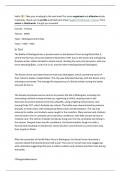Hello ! Take your studying to the next level! For more organized and effective study
materials, check out my profile and flashcard shop Maggie's Flashcards - Payhip. From
notes to flashcards, I've got you covered!
Course : History
Theme : WWII
Topic : Stalingrad and D-Day
Years : 1942 - 1943
In Text
The Battle of Stalingrad was a pivotal event on the Eastern Front during World War II,
where the German army was halted in November 1941 due to the harsh and unforgiving
Russian winter. Hitler decided to attack south, dividing his army into two parts, with one
force attacking Baku, a city rich in oil, and the other heading towards Stalingrad.
The Soviet Union was determined to hold onto Stalingrad, which carried the name of
their nation's leader, Joseph Stalin. The city was defended fiercely, with the Soviet army
refusing to surrender. The average life expectancy of a Soviet soldier during the battle
was just 24 hours.
The Soviets employed various tactics to prevent the fall of Stalingrad, including not
evacuating civilians to keep morale up, organizing a militia, staying close to the
Germans to prevent attacks from the Luftwaffe, using a fighting retreat tactic, and
issuing Order 227, which forbade any retreat. The battle was characterized by extreme
brutality on both sides, with widespread destruction and devastation. The city was
reduced to rubble, and civilians were caught in the crossfire. Many women and children
were forced to live in cramped and unsanitary conditions, with little access to food or
medical care. The stench of death and decay hung over the city, as bodies lay rotting in
the streets. Despite these horrific conditions, the Soviet soldiers fought on with a
ferocity that bordered on fanaticism, driven by their commitment to communism and
their loyalty to Stalin.
After the surrender of the 6th Nazi Army in Stalingrad, the Soviet Union launched a
counter-attack that lasted almost half a year. The cost in human lives was staggering,
with estimates suggesting that over a million soldiers and civilians lost their lives during
the battle.
©MargaridaVeríssimo
, On the other hand, D-Day was the Allied invasion of Normandy on June 6, 1944, during
World War II. A total of 156,000 troops landed on five beaches in Normandy, hailing from
countries such as the United States, Canada, Australia, New Zealand, United Kingdom,
France, Poland, and Norway. The battle of Normandy lasted approximately two and a
half months.
The Allies employed a deception campaign to mislead the Germans about their plans
and intentions. This strategy involved spreading false information or creating a false
impression of capabilities to gain an advantage. The successful execution of D-Day
marked a significant turning point in the war.
©MargaridaVeríssimo




